
In product management, a product launch timeline serves as a roadmap to ensure a well-structured and successful product release.
So in this article, let’s review a product launch checklist to help you prepare a solid campaign that gets traction and sows the seeds for consistent growth.
Try Userpilot Now
See Why 1,000+ Teams Choose Userpilot

TL;DR
- Product launch timelines are detailed roadmaps that outline the key stages and milestones required to bring a product to market successfully.
- Key elements of a successful launch include pre-launch activities, launch-day tasks, and post-launch activities.
- The pre-launch phase involves:
- Performing customer research to define the launch scope. This can involve sending surveys, analyzing user data, and doing market research.
- Determining the launch scope by identifying the target audience, crafting key messages, and selecting appropriate communication channels.
- Deciding the product launch date, which involves considering market timing, resource availability, and buffer time for unforeseen delays.
- Developing a product launch strategy. This includes setting strategic goals, planning the go-to-market approach, and preparing teams for the launch.
- Establishing clear roles of stakeholders for a cohesive process, as well as setting up effective communication channels.
- The launch-day activities include:
- Execute a marketing campaign across channels like Product Hunt, in-app announcements, and social media.
- Monitoring your product launch timeline by tracking performance metrics and having contingency plans in case certain goals are not met.
- The post-launch stage focuses on:
- Gathering and analyzing customer feedback post-launch to identify areas of improvement and enhancing the product.
- Monitoring product performance by tracking metrics like user engagement, adoption rate, retention, churn, and product stickiness.
- Iterating on the product based on feedback by using product analytics to identify and address issues.
- Planning for product updates by following a roadmap that prioritizes impactful improvements and manages resources effectively.
- If you’re a product manager, book a Userpilot demo to see how you can collect user data, enhance the product experience, and iterate your product.
When planning your product launch timeline, how do you determine the scope?
How do you communicate the launch to your existing user base?
What is your process for the post-launch phase of your timeline?
Master every stage of your product launch timeline with Userpilot.
From pre-launch research to post-launch iteration, ensure your releases drive actual growth.
What is a product launch timeline?
A product launch timeline is a detailed roadmap that outlines the key stages and milestones required to bring a product to market successfully. It ensures that all critical tasks are completed on time—from initial planning and development to the actual launch and post-launch analysis.
Key elements of a successful product launch timeline
A well-executed launch plan can significantly impact your product’s initial adoption and long-term success.
This involves three key elements:
- Pre-launch activities: Besides building anticipation through teaser campaigns and pre-registration. This stage involves gathering customer data, determining the launch scope, and preparing teams with the resources they’ll need to deal with the demand.
- Launch day activities: Once the product is live, the focus shifts to executing the marketing strategy, managing real-time events, and monitoring performance metrics to make sure the product is working as intended.
- Post-launch activities: After the launch, it’s crucial to follow up with users to gather feedback, maintain engagement, and plan for future updates.

Product pre-launch timeline and task checklist
The pre-launch phase is all about laying the groundwork for a successful product launch.
For this, let’s go over the critical tasks you need to complete during the pre-launch phase:
Plan to gather and analyze customer data
Gathering customer data is necessary to determine the launch scope, the target market, and the key message you’re going to promote.
It will also help you decide which features to prioritize, find out how to tailor the product to meet customer needs, and estimate the human resources required for it.
This can involve:
- Sending targeted surveys to your user base to identify the most requested features.
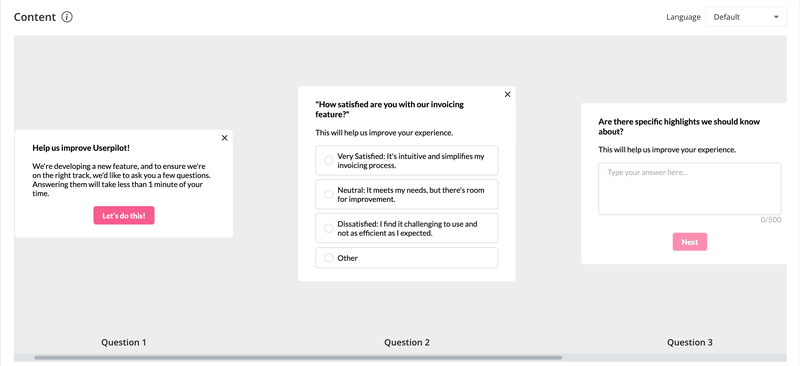
- Analyzing their interactions with your existing products to spot potential pain points.
- If you don’t have any product or user base yet, you can still perform market research to look at industry trends and what your competitors are offering.
For instance, if 68% of your feature request responses are asking for a specific feature, then you might prioritize that feature in the new product.
Determine launch scope and messages
With the data collected, you can now define the scope of your product launch—ensuring that you’re promoting the right product to the right people and through the right channel.
This scope has three key elements:
- Target audience: This includes the demographics, behavior, and needs of your potential customers.
- Key messaging: The core messages that address the pain points of your audience and the benefits that your product can bring to their lives.
- Communication channels: What platforms you’re going to use to promote your new product? This involves in-app notifications, email, social media, and platforms like ProductHunt. For example, you can use a tool like Userpilot to communicate new products inside your app.
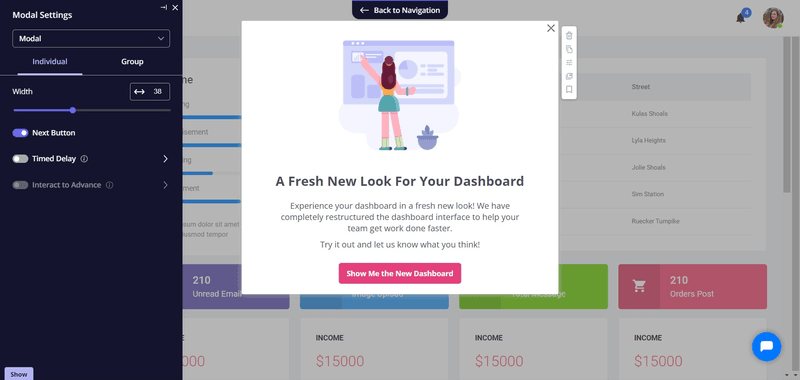
Decide the launch date
What are the most important factors you should consider for your launch data?
Here’s a couple:
- Market timing: Consider seasonality, industry events, and competitor activity. Is your product more valuable during a specific quarter? Is there another important launch in your market that might overshadow your product?
- Resource planning: Do you have to procure more resources for your team to deal with increased demand? Do you need to hire a couple more team members? How long will that take?
- Buffer time: What period will give you enough room for unexpected delays or last-minute adjustments?
Develop a product launch strategy
With a launch date, you now need to ensure that your product launch strategy is perfectly executed. For this, there are three critical components you must set up:
- Strategic goals: Set solid objectives, such as target sales or revenue goals. You can use the SMART framework to set more actionable goals.

- Go-to-market strategy: Define how you will introduce the product to the market. This includes the pricing, your positioning statement, partnerships, and the specific marketing campaigns you’re going to promote.
- Team preparation: Train your sales and support teams to effectively communicate the product’s values and handle customer queries once the product is live.
Identify stakeholders for the launch plan
A successful product launch requires that your teams can work together, collaborate, and understand their roles during the launch.
For this, start by identifying the key stakeholders that are indispensable for the launch, such as product managers, marketers, product developers, and sales teams. Then, clearly define each stakeholder’s responsibilities and ensure that everyone knows their role in the launch process to prevent overlaps.
You can leverage team management tools like Clickup, Asana, etc., for this.
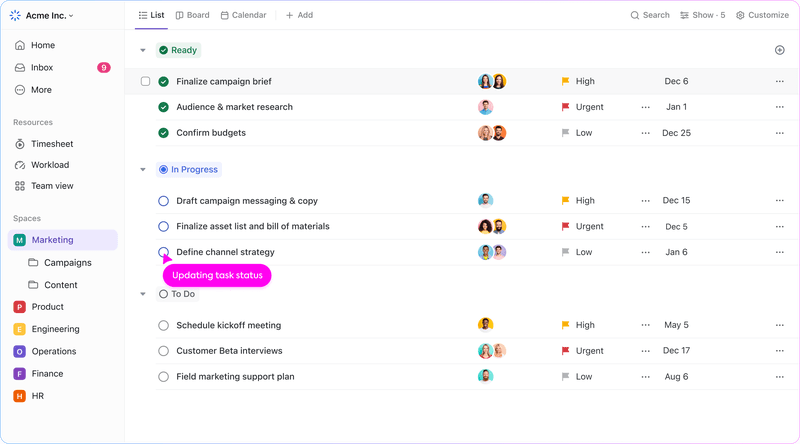
Once roles are established, set up effective communication channels to keep the project on track. This involves regular check-ins, meetings, and using project management software to address emerging issues quickly.
This way, you can ensure that the entire team is on the same page when the product launches.
Product launch timeline and task checklist
During launch day, execution is key. Below are the essential tasks to execute on the day of the launch:
Execute your product marketing campaign
The success of your product launch hinges on a well-executed marketing campaign that drives awareness.
Here are some channels where you can execute your launch campaign:
- Product Hunt: Prepare your Product Hunt listing with compelling visuals and clear messaging. Then, engage with the community by responding to comments and gathering feedback in real-time.

- In-app announcements: Use in-app notifications to inform existing users about the launch. For this, highlight new features with GIFs or video tutorials.
- Social media: Schedule posts across your social media channels to generate buzz. You can also use targeted ads if necessary to reach a broader audience.
For instance, if your new product is a tool inside your platform, you might create an interactive demo video, share it on Product Hunt, and promote it through in-app announcements to ensure the existing user base is aware of it.
Monitor and manage launch events
Monitoring your launch helps you stay informed about how your product is being received in real time and identify areas that may need attention.
Some metrics you should pay attention to include:
- Active users.
- Product Hunt votes.
- Sales
- Website traffic.
- Feature engagement.
- Support tickets.
Note: It’s essential to have contingency plans. For example, if your Product Hunt votes don’t make it to the release list email, you might decide to ramp up social media efforts, initiate an additional email campaign, or explore other marketing channels to boost visibility and engagement.
Product post-launch timeline and task checklist
The goal of the post-launch phase is to ensure the long-term success of your product.
Here are the essential tasks to focus on after the launch:
Gather and analyze customer feedback
After launch, it’s essential to gather feedback systematically to gain insights into user experiences and identify areas for improvement.
For this, you can trigger contextual surveys to collect targeted feedback, especially for features that are still in beta or require additional refinement.
This way, you can identify common themes and pain points that may not have been apparent during the development phase. For example, if multiple users report problems with a specific integration, this should prompt them to take immediate action and fix it by the next update.

Monitor product performance
Just like gathering feedback, monitoring product performance post-launch allows you to track how your product is being used and identify other types of areas that may need adjustments.
Some key product performance metrics you can track include:
- User engagement metrics: Including session length, feature usage, and time spent on key activities.
- Product adoption rate: It indicates how effective your product is in showing its value earlier, as well as identifying potential friction in some features.
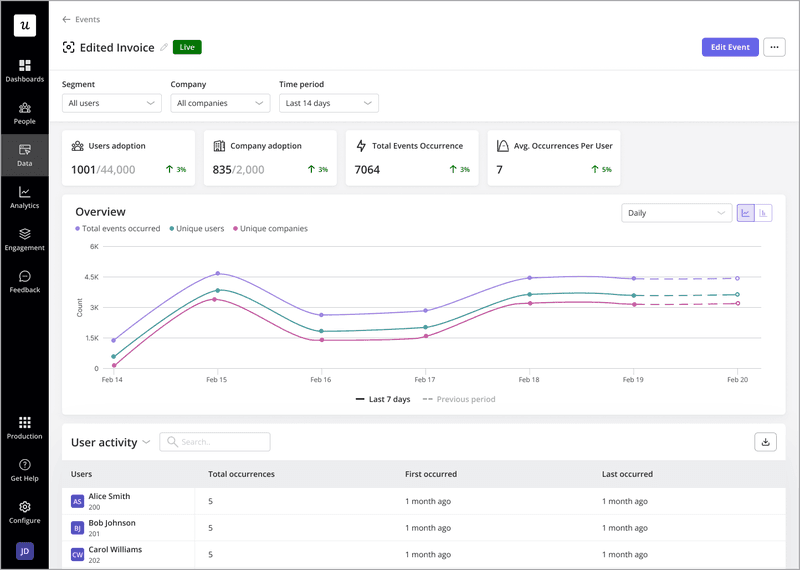
- Retention rates: Reflects your product capacity to deliver value consistently.
- Churn rate: Helps to identify potential issues that drive users away.
- Product stickiness: Evaluates how essential the product has become to users.
For instance, if you notice a decline in user engagement with a particular feature, it may indicate that you need to improve its usability or provide clearer guidance.
Iterate on product based on feedback
Once you’ve gathered feedback and user data, the next step is to use product analytics to identify issues and develop solutions for the next update.
For this, you can use a product management tool like Userpilot to perform multiple analysis, such as:
- Feedback analysis to identify sources of dissatisfaction, friction, and potential bugs.
- Funnel analysis to spot what steps of the user journey are facing the most drop-offs, and address them.

- Path analysis to figure out how users navigate your product, identify the happy path of your power users, and find ways to streamline the product experience so users are more likely to achieve success.
For instance, if users consistently find a particular feature difficult to navigate, prioritizing a redesign or enhanced user guidance in the next update can significantly improve their experience and loyalty.
Plan for product updates
After using product analytics and coming up with potential solutions, you must follow a product roadmap that outlines the timeline for implementing these new features and improvements.
For this, you can use a roadmapping tool like Jira or Aha! And then decide whether you want your roadmap to be public or purely internal.
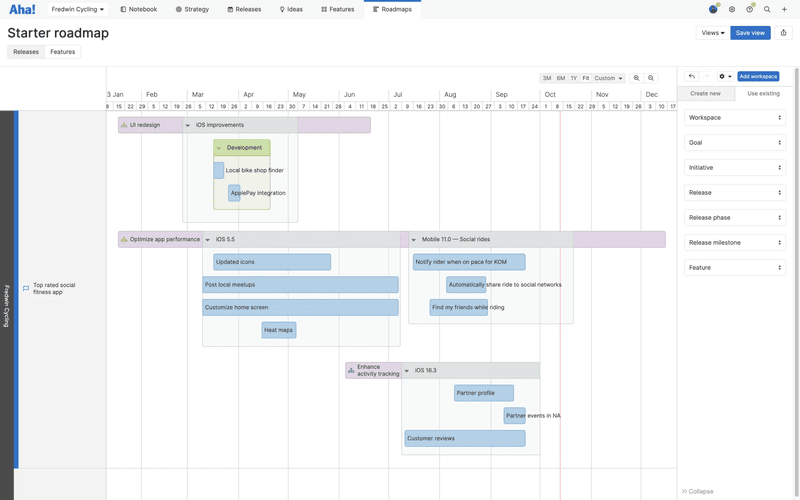
What matters for your roadmap is that it should prioritize updates that will have the most significant impact on user satisfaction and product performance. This can include app-breaking bugs or obstacles that are generating churn.
Conclusion
A well-structured product launch timeline is the precursor of a successful product.
By following detailed task checklists for each phase—pre-launch, launch, and post-launch—you can ensure that every aspect of your launch is meticulously planned and executed.
So if you’re a product manager, book a Userpilot demo to see how you can collect user data, enhance the product experience, and iterate your product.








